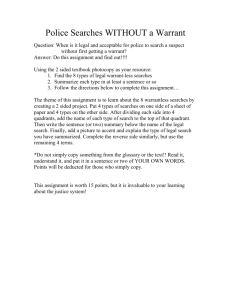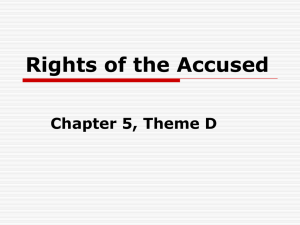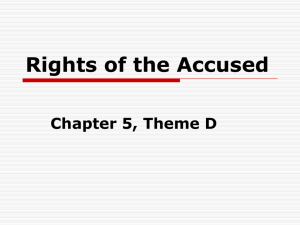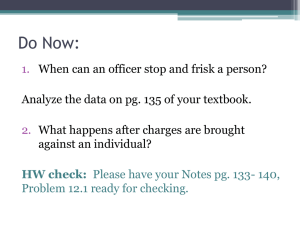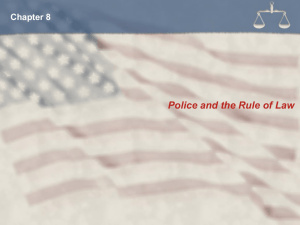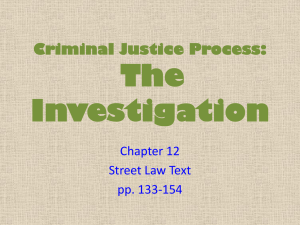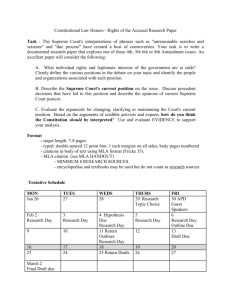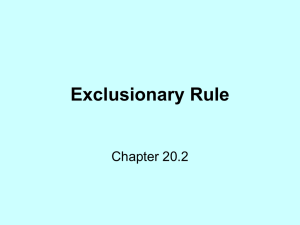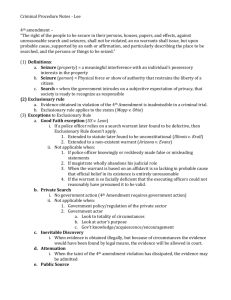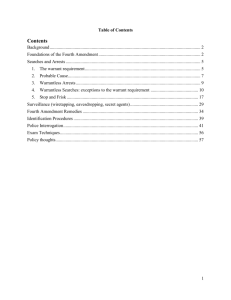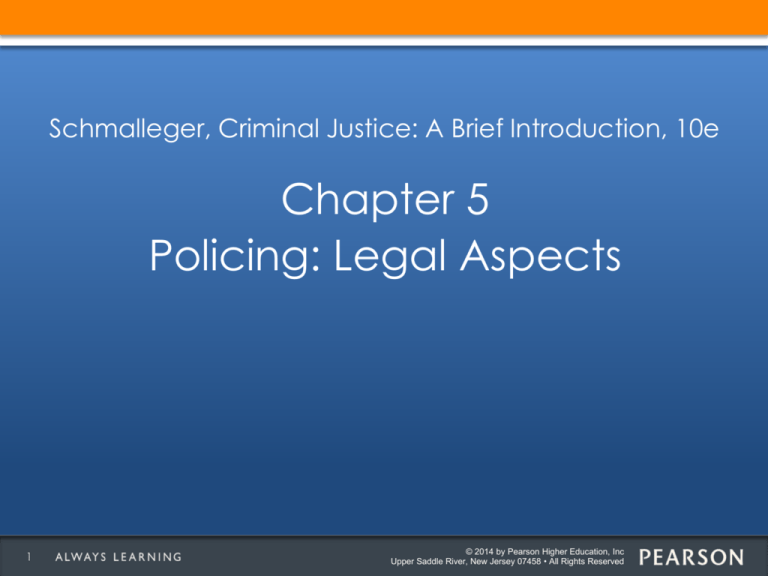
Schmalleger, Criminal Justice: A Brief Introduction, 10e
Chapter 5
Policing: Legal Aspects
1
© 2014 by Pearson Higher Education, Inc
Upper Saddle River, New Jersey 07458 • All Rights Reserved
CHAPTER OBJECTIVES
5.1
Describe legal restraints on police action.
5.2
Describe the circumstances under which police officers may conduct
searches or seize property legally.
5.3
Define arrest, and describe how popular depictions of the arrest
process may not be consistent with legal understanding of the term.
© 2014 by Pearson Higher Education, Inc
Upper Saddle River, New Jersey 07458 • All Rights Reserved
Learning Objectives
After this lecture, you should be able to complete the following Learning Outcomes
5.1
Describe legal restraints on police
action.
5.1
Constitutional Amendments
This Right is Guaranteed
By This Amendment
The right against unreasonable searches and seizures
Fourth
The right against arrest without probable cause
Fourth
The right against self-incrimination
Fifth
The right against “double jeopardy”
Fifth
The right to due process of law
Fifth, Sixth, Fourteenth
The right to a speedy trial
Sixth
The right to a jury trial
Sixth
The right to know the charges
Sixth
The right to cross-examine witnesses
Sixth
The right to a lawyer
Sixth
The right to compel witnesses on one’s behalf
Sixth
The right to reasonable bail
Eighth
The right against excessive fines
Eighth
The right against cruel and unusual punishments
Eighth
The applicability of constitutional rights to all citizens, regardless of state law or
procedure
Fourteenth
4
5.1
Knowledge Check Question!!!
The right against unreasonable searches and
seizures are guaranteed under which
Constitutional Amendment?
1. Fourth Amendment
2. Fifth Amendment
3. Sixth Amendment
4. Eighth Amendment
Learning Objectives
After this lecture, you should be able to complete the following Learning Outcomes
5.2
Describe the circumstances under
which police officers may conduct
searches or seize property legally.
5.2
Individual Rights
• Landmark case
– A precedent-setting court decision that
produces substantial changes in the
understanding of the requirements of due
process and the practical day-to-day
operations of the system
7
5.2
Search and Seizure
Fourth
Amendment
Warrant
Illegally
seized
evidence
Exclusionary
Rule
Weeks v. U. S.
(1914)
Evidence
illegally seized
by the police
cannot be used
in a trial
Acts as a
control over
police behavior
At the time,
only binding on
the federal
agents
A writ issued
from an
appellate
court for the
purpose of
obtaining the
lower court’s
records of a
particular
case
A mechanism
for
discretionary
review
Legal
principle that
excludes from
trial any
evidence later
developed as
a result of
illegal search
and seizure
Silverthorne
Lumber Co. v.
U. S. (1920)
5.2
The Warren Court (1953-1969)
• Mapp v. Ohio (1961)
– Made the exclusionary rule
applicable to criminal prosecutions at
the state level
– This started the Warren Court on a
course that would guarantee
recognition of individual rights
9
5.2
Searches Incident to Arrest
Chimel v.
California
(1969)
Immediate
control
Minnesota v.
Olson
(1990)
Extended
protection
against
warrantless
searches to
overnight
guests in the
name of
another
Reasonable
expectation of
privacy
One resident
gives
permission but
the other says
no
5.2
Good-Faith Exceptions to the Exclusionary
Rule
• Good-Faith Exception
– Evidence seized on the basis of good faith but
later shown to be a mistake may still use the
seized evidence in court
• U. S. v. Leon (1984)
• Probable cause
– A set of facts that would induce a reason
person to believe that a crime was committed
11
5.2
The Plain View Doctrine
• Plain view
– Evidence visible to the police may be seized
without a warrant as long as the police have a
legal right to be in the viewing area and
cause to believe the evidence is somehow
associated with criminal activity
• Harris v. U. S. (1968)
12
5.2
Emergency Searches of Property and
Emergency Entry
Warrantless search justified on the basis of some
immediate and overriding need
5.2
Anticipatory Warrants
• Anticipatory warrant
– Warrant issued on the basis that
evidence, not currently at the place
described, will likely be there when the
warrant is executed
14
5.2
Knowledge Check Question!!!
What U.S. Supreme court decision forms
the basis of the exclusionary rule?
1. Miranda v. Arizona
2. Gideon v. Wainwright
3. U.S. v. Leon
4. Weeks v. U.S.
5.2
Knowledge Check Question!!!
Which case made the exclusionary rule
applicable to criminal prosecutions at
the state level?
1. Weeks v. U.S.
2. Miranda v. Arizona
3. Mapp v. Ohio
4. Terry v. Ohio
5.2
Knowledge Check Question!!!
Which case limited the police officer’s
right to search incident to an arrest to
the area under the immediate control
of the person arrested?
1. Mapp v. Ohio
2. Chimel v. California
3. U.S. v. Leon
4. Arizona v. Hicks
5.2
Knowledge Check Question!!!
In this case, the U.S. Supreme Court
ruled that police officers may not enter
a home to conduct a warrantless
search if one resident gives permission
but the other says no.
1.
2.
3.
4.
Georgia v. Randolph
Terry v. Ohio
Illinois v. Rodriquez
Coolidge v. New Hampshire
5.2
Knowledge Check Question!!!
Which case is known as the good-faith
exception?
1. Minnesota v. Carter
2. Georgia v. Randolph
3. Nix v. Williams
4. U.S. v. Leon
Learning Objectives
After this lecture, you should be able to complete the following Learning Outcomes
5.3
Define arrest, and describe how
popular depictions of the arrest
process may not be consistent with
legal understandings of the term.
5.3
Arrest
The act of taking an adult or juvenile into physical
custody for the purpose of charging the person with a
criminal offense
21
5.3
Searches Incident to Arrest
A warrantless search of an arrested individual to
ensure the safety of the officer
Terry v. Ohio (1968)
Reasonable Suspicion
Would justify an officer in
making further inquiry or in
conducting further
investigation
22
5.3
Emergency Searches of Persons
FBI guidelines for conducting searches
•There was probable cause at the time of the search to
believe that evidence was concealed
•There was probable cause to believe an emergency
threat of destruction of evidence existed
•The officer had no prior opportunity to obtain a warrant
•Action was no greater than necessary
5.3
Police Interrogation
• Interrogation
– The information-gathering activity of police that involves
direct questioning of suspects
24
•
Physical abuse
– Brown v. Mississippi (1936)
•
Inherent coercion
– Tactics used by police interviewers that fall short of
physical abuse but pressure the suspect to talk
5.3
Psychological Manipulation
• Psychological Manipulation
– Manipulative actions by police
interviewers, designed to pressure
suspects to divulge information, that
are based on subtle forms of
intimidation and control
25
5.3
Suspect Rights: The Miranda Decision
• Miranda v. Arizona (1966)
• Miranda Warnings
– The advisement of rights due criminal suspects
by the police before questioning begins
26
5.3
Suspect Rights: The Miranda Decision
• Inevitable-Discovery exception to Miranda
Evidence can be used in court if it would
invariably turned up in the normal course of
events
• Public-Safety exception to Miranda
27
5.3
Suspect Rights: The Miranda Decision
• Miranda Triggers
– The dual principles of custody and
interrogation
28
5.3
Knowledge Check Question!!!
Miranda warnings must be given if the
offender is being interrogated but is not
under arrest.
1. True
2. False


